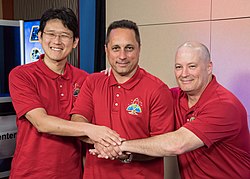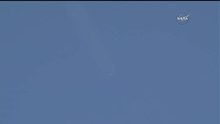Soyuz MS-07
| Mission emblem | |||
|---|---|---|---|

|
|||
| Mission dates | |||
| Mission: | Soyuz MS-07 | ||
| COSPAR-ID : | 2017-081A | ||
| Spacecraft: |
Soyuz 7K-MS ( GRAY index 11F747) serial number 737 |
||
| Launcher: | Soyuz FG (GRAY index 11A511FG) | ||
| Call sign: | Астрей (" Astraios ") | ||
| Crew: | 3 | ||
| Begin: | December 17, 2017, 07:21 UTC | ||
| Starting place: | Baikonur 1/5 | ||
| Space station: | ISS | ||
| Docking place: | Rasswet | ||
| Coupling: | December 19, 2017, 08:39 UTC | ||
| Decoupling: | June 3, 2018, 09:16 UTC | ||
| Duration on the ISS : | 166d 0h 37min | ||
| Landing: | June 3, 2018, 12:39 UTC | ||
| Landing place: | 156 km SE of Sheqasghan , Kazakhstan | ||
| Flight duration: | 168d 5h 18min | ||
| Earth orbits: | 2688 | ||
| Team photo | |||
 Norishige Kanai, Anton Schkaplerow and Scott Tingle |
|||
| ◄ Before / After ► | |||
|
|||
Soyuz MS-07 is a mission name for the flight of the Russian spacecraft Soyuz to the International Space Station . As part of the ISS program, the flight is designated ISS AF-53S. It is the 53rd visit by a Soyuz spacecraft to the ISS and the 159th flight in the Soyuz program.
crew
Main crew
- Anton Nikolajewitsch Schkaplerow (3rd space flight), Commander ( Russia / Roscosmos )
- Norishige Kanai (1st space flight), flight engineer ( Japan / JAXA )
- Scott Tingle (1st space flight), flight engineer ( USA / NASA )
Substitute team
- Sergei Valerjewitsch Prokopjew (1st space flight), Commander (Russia / Roscosmos)
- Alexander Gerst (2nd space flight), flight engineer ( Germany / ESA )
- Jeanette Epps (1st spaceflight), flight engineer (USA / NASA)
Mission description
The mission brought three crew members from ISS Expeditions 54 and 55 to the International Space Station. The flight was originally scheduled for December 27, 2017. NASA asked Roskosmos, however, to move it forward so that no staff had to be on hand for the Christmas celebrations in Baikonur. However, the ISS was now on a flight path that was not suitable for the short “express approach”. That is why the classic two-day approach was used again for this mission.
The undocking took place on June 3, 2018 at 09:16 UTC, so the ISS Expedition 56 began on the station with Andrew Feustel as commander. The landing took place on the same day approx. 3 ½ hours later in the Kazakh steppe 147 km southeast of Scheskasgan .
gallery
See also
- List of Soyuz missions
- List of manned missions to the International Space Station
- List of manned space flights
Web links
- Soyuz MS-07 at spacefacts.de
- Soyuz MS-07 on the Russian Space Web
- Soyuz MS-07 in the Encyclopedia Astronautica (English)
- Soyuz MS-07 in the NSSDCA Master Catalog (English)
Individual evidence
- ↑ Soyuz MS-07 crew begins two-day trek toward ISS. Spaceflight Insider, December 17, 2017, accessed December 17, 2017 .







